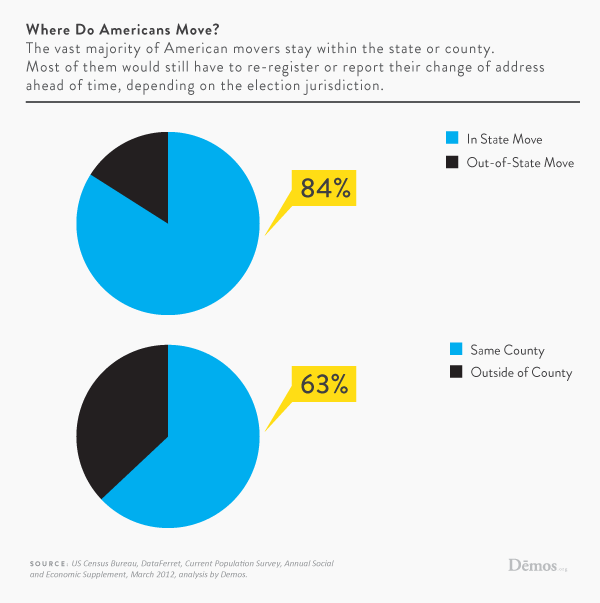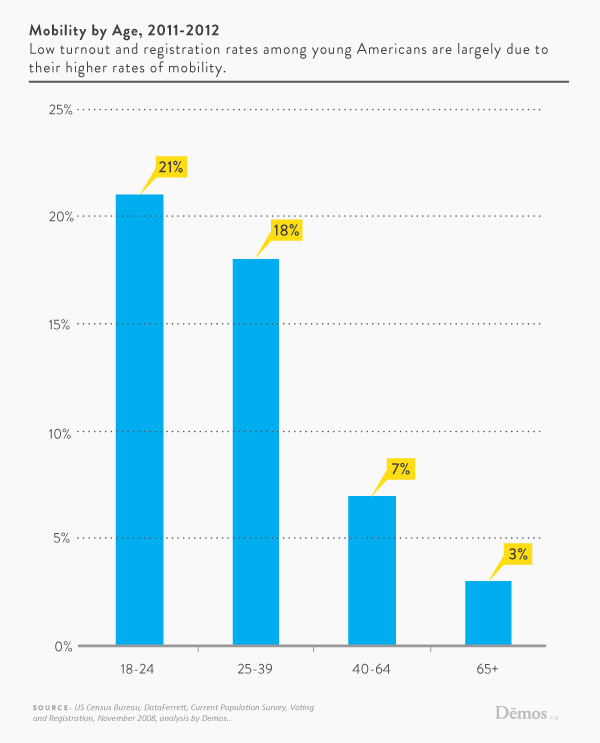Introduction
The freedom to vote is a cornerstone of American democracy. Voting brings us together as Americans and it is the one time we have an equal voice in the decisions that impact our lives and community. And yet, every year, millions of eligible voters fall through the cracks because they have moved sometime in the last year. Our antiquated voter registration system and patchwork of voter registration rules do not meet the needs of today’s mobile society. In 2008, about 79 million eligible voters sat out the presidential election. Among them, 4 to 5 million were not registered due to administrative procedures and approximately 4 million registered voters were prevented from voting due to administrative problems. Today, approximately 51 million eligible Americans are still not registered to vote.
However, straightforward policies like same day registration and voter registration modernization, in addition to the enforcement of existing laws like the National Voter Registration Act can easily bring all eligible Americans into the political process.

Moving can Jeopardize Voter Eligibility
The United States is a highly mobile society. Tens of millions of Americans move every year for a job, school, family, love and more. In the past few years, many families have lost their homes or have had to downscale due to economic hardship.
- Almost 23.5 million voting-age citizen-residents, or almost 1 in 10, moved in the one year period between 2011 and 2012.
- The vast majority of voting age citizen movers (84%) relocated to a new address within the same state between 2011 and 2012. Almost two-thirds (63%) stayed within the same county (see Figure 1).
- In early 2012, upwards of 2.0 million homes were in some stage of foreclosure.
People of color, low-income people and the young are even more likely to move:
- African Americans and Latinos are the most likely to move. Between 2011 and 2012, 13% of both African Americans and Latinos (of citizen voting-age population) reported changing addresses. Mobility rates were lower for whites and Asian, Hawaiian and Pacific Islanders at 10%.
- Low-income individuals are twice as likely to move as those above the poverty line. Between 2011 and 2012, 18% of those below the poverty line moved, compared to only 9% of those above the line.
- Young adults between the ages of 18 and 24 are the most likely to move. Between 2011 and 2012, 21% of young adults moved. Mobility rates dramatically decline for older age groups: only 18% among 25-to-39 year olds, 7% of 40-to-64 year olds, and 3% of those 65 and over. While young adults were the most likely to move, they were also the most likely to remain within the same state and/or county: 85% of 18-to-24 year old movers remained within the same state and 65% remained within the same county (see Figure 2).
- Subprime loans and home foreclosures are heavily concentrated in low-income and communities of color. In fact, even when controlling for income, communities of color have significantly higher foreclosure rates than predominantly white communities.

Moving can jeopardize one’s freedom to vote. Every time eligible voters move, they must re-register or report a change of address, often far ahead of the elections. And the requirements and process for reporting a change in address vary widely, depending on the election jurisdiction and whether it is a federal, state or local election. Less than 70% of eligible voters who lived at their current address for less than a year were registered to vote during the 2008 presidential election, compared to 85% of those who have lived at their current address for five years or more. The more you move, the less likely you are to be registered to vote.
States Vary Widely in their Policies
Every state and sometimes counties and towns have their own laws and rules for voting, especially those related to recent movers and address changes. There are 10,000 to 14,000 different ways elections are administered in this country.
In most states, movers must re-register or report their change of address at least 6 to 30 days before the election, depending on the state. About six states allow recent movers within the state to update their address and vote at their new polling place on Election Day and an additional nine states plus the District of Columbia offer Same Day or Election Day Registration (soon to be joined by Connecticut and California). North Dakota does not have voter registration.
Restrictive residency requirements can prevent recent movers from registering to vote and casting a ballot in their new community. Some states have a “grace period” for interstate movers, allowing those who moved shortly before the election (typically within 14 to 30 days) to vote at their old polling place. Mix-ups can easily occur for those who have moved short distances and are assigned a new precinct, which may still be at the same polling site. Different rules apply for those who have moved within the same county but are assigned to a different polling place.
Our Elections System Needs a 21st Century Upgrade
The requirements and processes of voter registration were developed in the 19th century and as a result fail to accommodate the needs of a much more mobile and changing citizenry that comprise our electorate today. Only about ten states offer online voter registration, and then only to a select group of people, namely those individuals who are already part of the motor vehicles department’s system). In the majority of states, eligible voters must visit the local elections office or a voter registration agency in person, or snail mail a paper voter registration application in order to become or remain registered to vote. Poll books are printed in hard copy and thousands of pages are flipped through at the polling sites to identify voters. While some counties have experimented with electronic poll books that can connect to other precincts and the statewide voter registration database, California, for example, has yet to develop its statewide voter registration database.
Policy Recommendations
There are several proven innovations that have been cost efficient and effective in ensuring all eligible voters are able to cast their ballots on Election Day. These policies include:
Enforcement of “fail-safe” voting provisions of the National Voting Rights Act (NVRA), which requires that registered voters who move within their registrar’s jurisdiction, typically a county but sometimes a municipality or town, be permitted to vote at their old polling place or a central location even if they have not notified the registrar of the address change.
Enforcement of Section 7 of the NVRA, which requires public assistance agencies to offer voter registration services like their state motor vehicle office counterparts. State public assistance agencies have been neglecting their voter registration obligations since the law was implemented in 1995-1996 and the number of voter registrations at public assistance agencies has plummeted. In several states, however, the trend has been reversing thanks to efforts by state officials and non-profit groups to re-implement the law. Full implementation of the NVRA can reach hundreds of thousands of the particularly mobile, low-income Americans who must report address changes when they move, which triggers the voter registration requirement.
Same Day Registration (SDR) would allow eligible voters to add or update their voter registration information on or during the period before Election Day. Voter registration databases are full of errors arising from data entry of paper applications. SDR also eliminates arbitrary voter registration deadlines. States with Same Day Registration have led the nation in turnout and SDR saves residents and elections officials time and money.
Modernize the voter registration system so that updates are automatically made to reflect a change in a voter’s address, all without the need for paper forms or in-person visits to election administration offices. State databases can be connected so that updates occur across the board and the data are accurate and up to date, protecting the integrity of the election while ensuring that all voters are able to exercise their right to vote. In addition, online voter registration should be universally available.
* This factsheet is an updated version of Democracy In a Mobile America by Scott Novakowski, July 2009.